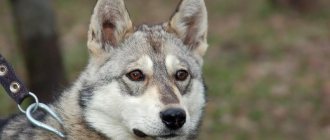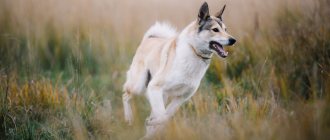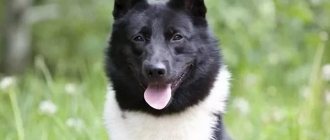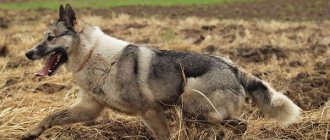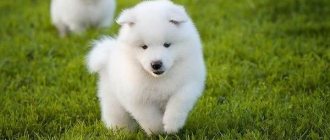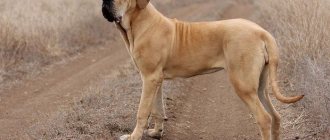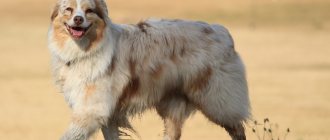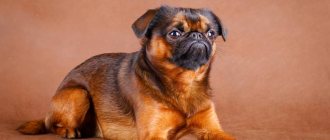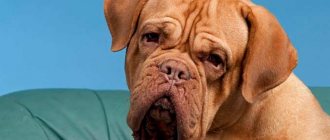History of the Russian-European Laika breed
The Russian-European Laika, as an independent breed, was created according to plan.
In 1949, Soviet breeders decided to give hunters another type of hunting dog, using the gene pool of the Karelian, Arkhangelsk, and Komi Laika as a basis. However, the most difficult thing for specialists turned out to be not to cross individuals from the listed offspring (such matings have long been practiced by amateurs), but to bring the resulting offspring to a single type. As an example: by the middle of the 20th century in the USSR there were about ten varieties of Russian-European huskies that had a very distant resemblance to each other. One of the very first and most prolific participants in the experiment is a dog named Tuzik, who belonged to the breeder Sh. A. Isaev. This native of the Komi Laika helped the birth of dozens of Russian-European Laika puppies, essentially becoming the official great-grandfather of the breed. As for the formation of a single exterior, it only happened in 1964, although work on individual lines of the breed continued until perestroika times. It is known, for example, that the most popular branches of Russian-European huskies originated from the male dogs Putik, Bublik and Sharik, and their representatives received from their ancestors excellent external characteristics and developed hunting instincts.
Since the early 70s, new breed groups of Russian-European Laikas began to appear. These are the Jack and Joy lines known to all modern breeders. Unfortunately, already in 1979, breeding hunting huskies lost its popularity, which was facilitated by the state ban on shooting squirrels. And although by that time the breed had made a good exhibition career, and a year later even received FCI registration, this fact had a negative impact on its development. Today, you can meet the Russian-European Laika hunting less often than its relatives, the Westerners. However, these versatile fishermen still have fans, which has helped them not to disappear and also maintain their performance characteristics.
Video: Russian-European Laika
Selection and cost of a puppy
When choosing a puppy, you should decide on the purpose of the purchase . There can be two of them: hunting and exhibition career. In the first case, you need to look for parents not with a pedigree, but with hunting experience. Excellent hunters give birth to beautiful puppies that, almost with their mother's milk, absorb all the wisdom of their future business. Pedigree, of course, in this case will simply protect against deception when purchasing. But if you take a dog for a show career, then first of all you need to look at the regalia of the parents (what titles they have).
Puppies show their hunting qualities from early childhood, so a specialist can recommend a specific baby as a good assistant
In Russia there are nurseries and private breeders of Russian-European huskies, so there is no need to take risks by purchasing a baby without documents.
In any case, a husky puppy should be very active and inquisitive. The cost of babies ranges from 15–30 thousand rubles. For a spotted puppy, look at the location of the spots, the main thing is that you like the appearance.
White dogs are more valuable because they are considered rare.
There are nurseries all over our country:
- "Lika puppies" Pushkino, Moscow region;
- "Spindle" Osha, Omsk region;
- “Bombor”, Semyonovka village, Smolensk region.
Breed standard Russian-European Laika
Russian-European Laikas have a very memorable appearance, which is partly due to the meager palette of colors. The dimensions of the representatives of the breed are average, the muscles are dry, and the dogs do not look thin-boned. The height of an adult male Russian-European husky is 52-58 cm; females - 48-54 cm. In general, “girls” have a more elongated silhouette (extension index in the range of 100-105), since this constitutional feature is necessary for bearing offspring. In other respects, males look brighter and more respectable than females, although they do not show significant advantages in work.
Head
Wedge-shaped outlines are typical for the heads of all Russian-European huskies. Between the dry, sharp muzzle and the skull there is a noticeable stop, which seems very sharp due to the convex brow ridges. The muzzle itself is shorter than the skull, while its upper line is parallel to the line of the forehead. The back of the head is rounded, with an easily palpable tubercle and parietal crest.
Lips, teeth and jaws
Elastic lips, tightly pressed to the jaws, do not form saggy jaws. The teeth are massive, even, closely spaced in a row. The only appropriate type of bite is a scissors bite.
Eyes
The Russian-European Laika has dark brown small eyes, which are characterized by a slightly slanted eyelid.
Ears
The shape of the ear is triangular, while the base of the hearing organ is wide and the tip is sharp. The ear position is erect. The ear membrane is small in size and extremely mobile.
Neck
Optimal proportions are when the length of the animal’s neck and head are the same. To the touch, the neck is very muscular, dry in outline, set in relation to the body at an angle of 45° to 50°.
Frame
Russian-European huskies are dogs of moderately strong build with a wide chest reaching down to the elbows and a straight, but not long, back. The animal's loin is convex, with a developed muscle corset. Belly with a clearly defined transition from the sternum to the abdominal area. The cereal zone is quite short, with a slight slope.
Limbs
REL's legs are dry, with well-pumped muscles, located parallel to each other when looking at the animal from the front. The shoulders are moderately oblique, the elbows are large, directed backwards. The pasterns are medium in size and have a slight slope.
The hind legs are formed by long shins and almost vertical metatarsals. The paws have the shape of a regular oval, thanks to the fingers compressed into a ball. Dewclaws are not welcome.
Tail
The husky's tail is crescent-shaped or ring-shaped, curved towards the back and pressed to the outer side of the thigh. When unfolded, the tail reaches the tarsal (hock) joint or is located at a distance of 1-2 cm from it.
Wool
The coat of the Russian-European Laika is a hard, straight coat and a thick undercoat layer. The dense hair covering the dog's head and ears is very short. The shoulders and neck are “dressed” in a rich spine, forming an expressive “collar”, and behind the cheekbones are stylish “sideburns”. Males have longer hair on the withers. The hair on the legs is short, close-lying, slightly lengthening only on the back of the limbs. There are neat feathers on the hind legs. Between the toes, the fur grows like a thick brush, while the paws are covered with short and smooth hairs. The tail is without dewlap, but with an elongated straight spine on the lower part.
Color
Russian-European huskies are born black and piebald, completely white, and also with a solid black color.
Possible defects
Serious defects in the exterior, for which the exhibition score is reduced, are called defects. For Russian-European Laikas these include:
- deviation from the height recorded by the standard by more than 2 cm;
- specks on the body, as well as specks that do not match the main color on the legs and head;
- the coat is loose, wavy or curly;
- long head, massive muzzle without stop;
- hanging or semi-erect ears;
- discord;
- hunchback and barrel chest;
- clubfoot or with splayed legs;
- straight or saber tail.
Character of the Russian-European Laika
The Russian-European Laika is a dog in love with its owner, and at the same time with all his associates, from family members to friends. Representatives of this family, in principle, are not prone to aggression towards humans, and when it comes to children, huskies immediately turn into the most good-natured and forgiving creatures in the Universe. The breed's territorial instinct is very moderately developed, so its representatives make mediocre watchmen. However, some breeders specifically cultivate protective qualities in their charges. Such individuals are noticeably more suspicious than their relatives and are no longer so loyal to strangers. If you need a dog that can be involved not only in hunting, but also in a simplified version of the ZKS (protective guard service), look for a seller who specializes in breeding guard huskies.
The main weapon in the fight against suspicious guests, available in the arsenal of every Russian-European husky, is a loud bark. By the way, about the “vocal abilities” of the breed: REL are happy to raise their voice with or without reason, and especially piercing concerts are staged by bored individuals. Accordingly, if you keep a Russian-European Laika in your apartment and are often away on business, get ready to ruin your relationship with your neighbors, who are forced to be unwitting listeners to your pet’s musical exercises.
The patience of Russian-European Laikas has become something of a legend, so a properly trained dog will always allow its owner to pull a bowl of food out from under its nose and will suppress any counter-protest. At the same time, dogs react sharply to unfair punishments, so before you slap a dog on the nose with a newspaper, think carefully about whether the pet deserves such treatment. Also consider the exercise needs of the breed. If the Russian-European Laika does not go hunting for a long time and at the same time lives in the house, destruction of the interior is inevitable. And the point here is not in the obstinate nature of the relics, but in natural instincts that do not find application in everyday life.
Hunting with Russian-European Laika
Russian-European huskies are universal hunters, in Russian realities they work excellently on both game and any animal. In addition to its sense of smell, the breed uses sight and hearing in its search, which makes hunting with reels as productive as possible. In addition, Russian-European Laikas are distinguished by the breadth and speed of their search, which helps them successfully compete with Westerners. A very important nuance: different techniques for working with game and animals, found in representatives of different breed lines. Typically, most relics work with their lower senses, following the scent directly, and only occasionally using their auditory receptors.
Some huskies belong to the high-sniffing type, that is, they are guided by the smell coming from the ground and distributed by the lower layers of air. Moreover, under different conditions, the dog can change its reconnaissance technique, moving from the upper to the lower scent and back. A separate category of REL are those who hunt by hearing. The sensitivity of such individuals is slightly less developed, therefore, in the process of pursuing prey, the animal often stops, then runs towards the sound and only barks at the prey in the end. In all respects, spirit huskies are considered ideal hunters, having equally developed sense of smell and hearing, but there are much fewer such individuals, and they are difficult to find.
Some experts recommend specially training your pet's hearing, starting from puppyhood. The Laika is taught to listen to the whisper of its owner, to pay attention to the sounds of living nature - the cries of birds, the knocking of a woodpecker on a tree. However, such exercises do not always give the desired result, since individuals with a dominant sense of smell will still prefer to rely on their nose rather than their own ears.
Education, training, grooming
The training of the Russian-European husky is based on helping the animal become a professional getter of forest and field trophies. The remaining service commands are discarded. At the same time, with a pet living in urban realities, you can take a UGS (controlled city dog) course. True, according to experienced hunters, such “education” does not have the best effect on the instincts of the breed. As a result, dogs trained in service commands perform much worse.
You can groom your future hunting husky from as early as three months, regardless of the time of year. Start with short walks in the forest and try not to make noise so that the puppy can listen to new sounds. The grooming technique also depends on what type of animal and game is to be hunted. For example, to work with waterfowl, you need to teach your puppy to overcome his fear of bodies of water. It is better to hunt the Russian-European husky hazel grouse in the fall and in those forests where young feathered animals definitely live.
Important: Russian-European huskies, who live in city apartments for years and go hunting only once a season, may lose their keen sense of smell. Usually the sense of smell is restored during work, but this does not happen immediately.
Mandatory skills for hunting huskies: walking next to the owner, willingness to sit down and give an object on command, including from the water. Breeders recommend organizing the training process with the help of additional equipment: a 20-meter leash with a carabiner, a plain whistle, a carrier (a piece of wood or a soft fabric toy). It is acceptable to use a thin rod when practicing the “No!” command. Traditional scheme: a dog caught picking up food from the ground is held at the “crime scene” and whipped sharply, but not too hard, with a vine. If you don’t have a rod at hand, it’s useful to pull the leash and voice the command. At the same time, it is strictly forbidden to hit a Russian-European husky with your hand or leash.
By the age of six months, a Russian-European Laika puppy is usually socialized: he knows his name and responds to it, is accustomed to walking on a leash, and has fit into the hierarchical system of the family in which he lives. At 6 months the animal can be prepared for hunting and trained. The first command to learn is “Near!” The owner takes the Russian-European husky outside, gives an order, patting himself on the thigh and at the same time pulling the puppy towards him by the leash. The strap is then gently released and the pet receives a rewarding pat or treat. By the way, for the latter it is better to buy a belt bag. Over time, the husky will understand where the owner hides the treats and will try to earn them.
When the Russian-European husky learns to walk side by side, start practicing the “Sit!” command. Everything is traditional here: after the order, the pet is gently pressed on the sacrum, forcing it to sit down on its hind legs. At the same time, the puppy is taught to give diarrhea correctly. The scheme is simple: shake a cloth stuffed animal in front of the animal’s nose. When the pet begins to grab the object with its teeth, throw it forward with the command “Give!”, and after the husky picks up the stuffed animal, gently take it away, rewarding the puppy with a treat.
If you plan to go waterfowling, teach your Russian-European Laika to swim. Only without extremes: throwing a puppy into the water, as home-grown “pros” do, is a harmful and empty activity that will provoke hydrophobia in the animal and nothing else. It is better to start by crossing shallow reservoirs (the owner goes first, followed by the puppy) and only in the warm season, since dogs also need time to get used to and harden. As for baiting large animals, it can be done at stations and with animals at least 1 year old. And of course, take into account the individual characteristics of your own pet: some huskies are not vicious enough for such an activity and are often frightened by potential prey that is larger than them.
Maintenance and care
Despite the growing popularity of apartment keeping of Russian-European huskies, the ideal housing for the breed remains a spacious enclosure, facing the south with a lattice and equipped with a warm booth. The mandatory “walking minimum” for the Russian-European Laika is from 2 to 3 hours a day, and it does not matter where your pet lives - in an apartment or in the courtyard of a country cottage.
You should not be afraid of the destructive behavior of Russian-European huskies living in houses. If the dog is walked and hunted enough, it will not cause chaos. The exception is puppies, who taste the world around them, but a compromise can be found with them. Provide your puppy with plenty of toys and frequent treats of cartilage and flat bones to give your puppy something to occupy his teeth.
Hygiene
Care for apartment and enclosure huskies will be different. The former, as a rule, are poorer dressed, since they live in a warm place, therefore, during winter hunting, such individuals freeze faster. Residential Russian-European huskies shed throughout the year, so brushing your pet several times a week will save your home from hairballs. Enclosure dogs shed their “coats” seasonally, that is, twice a year, which significantly saves the owner’s energy. Theoretically, yard huskies need to be brushed only during the molting period, but in practice this has to be done much more often, especially if the animal often goes hunting, where it can pick up burrs.
Important: Russian-European Laika puppies should not be washed. Only adult dogs are allowed to bathe, and only in cases where it is really necessary.
The ears of Russian-European huskies are cleaned as they become dirty using hygienic drops and a piece of clean cloth. If the amount of sulfur in the funnel is insignificant, do not disturb your pet in vain: the husky is not a decorative dog that needs to be washed and combed endlessly. The breed's eyes are healthy, so special care is not required for them. Just brush away dust bunnies from the corners of your eyelids and clean your eyes once a week with chamomile infusion and a tissue.
Remove accumulated plaque from your dog's teeth weekly: you can do this with a toothbrush or a silicone brush on your finger. An alternative to classic cleaning is hard treats like sinew, as well as carrots and tomato juice. During the hunting season, special attention should be paid to the legs of the Russian-European husky. If, upon examination, scratches or cuts are found on the paws, treat the wounds with an antiseptic. In winter, it is useful for urban huskies to lubricate their paw pads with protective creams that will protect their skin from toxic road reagents.
Feeding
Russian-European huskies are often fed animals they have hunted. The only caveat of this menu: a dog that eats hunting trophies will have to be treated for helminths more often. If work in the forest does not work out, the pet’s diet is based on any lean meat (from beef to poultry), raw tripe and offal. Once a week, meat can be replaced with fish fillet. To make dog dinners a little cheaper, they also add cereals – buckwheat and rice.
It is useful to dilute the meat component with seasonal fruits, young herbs, and vegetables. Russian-European huskies will not refuse fermented milk products, so get ready to periodically buy low-fat kefir, cottage cheese and fermented baked milk for your pet. To improve the appearance and thickness of the coat, it is recommended to treat your dog with a teaspoon of unrefined vegetable oil - it can be sunflower, olive or flaxseed oil.
Nutrition
Russian-European Laika puppies feed on their mother's milk for up to two months. If the conditions are different, the animal is fed artificial formula and then switched to dry food, which is soaked in water. From three months to six months, dogs eat five times a day. Then the number of feedings decreases. By the age of one year, the animal receives two portions - morning and evening.
Russian-European Laika puppies
If we talk about dry food, then the norms and dosages are already written on the packaging. Natural products should be given at the rate of 15-20 grams per kilogram of body weight. Puppies should receive fermented milk products - cottage cheese, eggs, natural yogurt without additives.
All this forms the skeletal system. In adulthood, the basis of the diet becomes protein - raw lean meat, scalded with boiling water. Offal, poultry and fish several times a month are also suitable. You can give cereals by boiling them or adding them to meat broths.
The dog also loves to eat vegetables, they improve peristalsis. Fruits should be given in moderation and only when they are in season. It is better to prefer thick food to liquid food. But pasta and potatoes should be excluded. You should not give bread, as well as any pastries and baked goods. Chocolate and other products made from cocoa beans should be prohibited.
a delicacy for any breed, and the Russian-European Laika is no exception. But you don't need to overdo it with them. Any bones have no nutritional value, but only clog the stomach. While training and training the dog, the owner can reward the pet with dried fruits, cheese or biscuits.
Health and diseases of Russian-European huskies
In purebred huskies, there are practically no hereditary diseases, with the exception of hip dysplasia, the mechanism of which is not yet fully understood. At the same time, you will still have to monitor your pet’s health, given its active lifestyle. For example, REL are often injured while hunting and can contract various infections there. Treatment of representatives of the breed against ectoparasites, as well as with anthelmintic drugs during the hunting season, is mandatory. Sometimes Russian-European Laikas are diagnosed with epilepsy and urolithiasis. In addition, some individuals may develop food allergies, which can be easily combated through a properly formulated diet.
Possible diseases
The Russian-European Laika breed is characterized by good health. Among large dogs, it is a real long-liver, capable of pleasing its owner for 14-15 years. It is distinguished by its endurance and immunity to various types of ailments. These dogs have almost no recorded diseases that can be transmitted at the genetic level, by inheritance.
As preventive measures to maintain health, good physical activity, a balanced diet, timely vaccinations and periodic visits to the veterinary office are recommended. Vitamin supplements should be added to natural food. This will reassure your dog of bone problems.
The most common disease in the breed is stones in the urinary tract. As a rule, the disease is characteristic of older dogs. Another pathology that is rare for any breed is loss of voice.
How to choose a puppy
- Collect as much information as possible about the sires of the litter: presence of exhibition diplomas, pedigrees, exterior, tests for genetic dysplasia.
- Do not look for show puppies from breeders who breed purely working lines and vice versa. Hunting huskies will never have such a glamorous exterior as their show relatives, and show dogs are not as productive when hunting.
- Choose a female Russian-European husky if you are going to “work the fur” - when hunting squirrel and sable, “girls” are always more collected and prudent.
- For wild boar hunting, it is better to choose males - they are more passionate, angrier and an order of magnitude bolder than females.
- If the seller has not provided a litter inspection certificate, there is a high probability that there are mixed breeds in it, because of which the breeding commission refused to issue the documents to the breeder.
- Try to visit the kennel in advance so as not to pick up the last remaining puppy. Assess the entire litter: it is ideal if all the babies are approximately the same size.
- Maximum attention should be paid to the shape of the puppy’s head and bite, since it is these exterior indicators that determine the breed of Russian-European Laikas.
- It is not recommended to take the most dominant puppy in the litter: as he matures, such a puppy will try to lead in hunting and in everyday life.
- Test the hearing acuity and sensitivity of Russian-European Laika puppies before purchasing. Click your fingers above the kids' heads and see which one reacts first to the noise. The sense of smell is tested with a bowl of food placed at a distance from the animals. The puppy that smells the treat first will be the most instinctive in the litter.
- When buying an adult dog with a show diploma, pay attention to how it behaves in the ring. If the pet does not walk next to the owner and barks angrily at everyone, hunting with such a dominant will not be successful.
Laika nurseries. - Voilochnikov A.
The great importance of husky nurseries in the creation and improvement of modern factory breeds of these wonderful hunting dogs is well known. Kennels are also of great importance in the modern period, since they are the main suppliers of pedigree puppies to hunters in fishing areas. By the end of 1975 In the RSFSR there were seven husky nurseries, including five in the consumer cooperation system, two in the Glavohota system of the RSFSR. Since many hunters are interested in the breeds of hunting dogs that are bred in nurseries, as well as the possibility of purchasing pedigree puppies, we give a brief description of the activities of existing nurseries. One of the oldest is the experimental nursery VNIIOZ in Kirov. It was organized in 1944 and was first located in the village of Bezborodovo, Zavidovsky district, Kalinin region. In 1959, this nursery was transferred to the Kirov region and located in the VNIIOZ animal farm. Since the day of its organization, the VNIIOZ nursery has carried out selection and breeding work with two breeds of huskies: Russian-European and West Siberian. Since the late 60s, Karelian-Finnish huskies have also been bred here. Laikas are bred in the nursery using lines, a detailed description of which is given in the work of S. A. Larin and S. D. Filatova (1971). Currently, the population of huskies at the VNIIOZ nursery is of high breed. Almost all dogs have excellent and very good conformation scores. Dogs rated “good” are kept in rare cases - either those that are distinguished by high working qualities, or those that come from outstanding sires and give good offspring. Special attention is paid to training dogs and identifying their working qualities. Training is carried out both in the forests adjacent to the nursery and in the hunting area assigned to VNIIOZ, where dogs are taken in the summer and autumn months. The training is mainly carried out on squirrel and upland game. Conditions for training are usually satisfactory. During years of low squirrel numbers, many young dogs remain untrained. Despite this, the number of certified huskies in the VNIIOZ nursery is usually within 45-55% of the adult population. In the 70s, the VNIIOZ nursery annually sent from 250 to 290 pedigree puppies to fishing areas. Russian-European Laika puppies are sold in the taiga regions of the European North, and Western Siberian Laika puppies are sold in the regions and territories of the Urals, Western and Central Siberia. Puppies of Karelian-Finnish huskies came mainly to the formation of the Kirov center of this breed and to the Karelian Autonomous Soviet Socialist Republic. The VNIIOZ kennel does not sell puppies to individual buyers. They are implemented in a planned manner at the request of regional (territory) consumer unions, which are received by VNIIOZ at the end of each year. A little later than the VNIIOZ nursery, the Laika nursery of the Yaroslavl Regional Consumer Union was organized, which is located 40 km from Yaroslavl and is located near the station. Lyutovo (on the Yaroslavl - Kostroma railway). In the Yaroslavl nursery, only Russian-European huskies are bred, the total number of which was small. In the early 70s, there were only 30 huskies of the main (reproductive) livestock, of which 25 were females. The sale of puppies in these years was in the range of 30-60 per year, which can be explained by insufficient attention to the matter. The breed level of Russian-European Laikas from the Yaroslavl nursery is average, but they have somewhat rough head shapes. Linear breeding is not practiced in the nursery. In the Yaroslavl nursery, pedigree puppies are purchased mainly by individual hunters. In 1957, the Khabarovsk nursery of West Siberian huskies was organized with a main population of 45 females and 5 males (Yudina, 1975). This nursery was initially subordinate to the regional department of hunting and fishing and was located in the village of Golubichnoye, Kur-Urmisky district, located 90 km from Khabarovsk. In 1966, the Khabarovsk nursery was transferred to the Lazovsky State Industrial Enterprise and transferred to the village of Bichevoye. In the first period of its activity, the Khabarovsk nursery established itself well. At this time, many pedigree puppies from it were sold to hunters in the fishing regions of the Far East. After the transfer of this nursery to the Lazovsky State Industrial Enterprise, its reproductive population sharply decreased. In the late 60s - early 70s, only 9-12 females and 5 males of the main stock were kept here. Almost no attention was paid to training huskies and testing their working qualities. Due to poorly done selection work, the dogs from this kennel showed signs of degeneration and shredding. According to recent reports (“Hunting and Hunting Management”, 1975, No. 10, p. 42), the Department of Hunting and Fishing under the Regional Executive Committee has implemented a number of measures aimed at improving the work of the nursery, which may lead to an improvement in its activities. In 1959 The Department of Hunting and Fisheries under the Novosibirsk Regional Executive Committee began to create a nursery for West Siberian huskies in the village. Kubovaya, located 35 km from the regional center. Currently, the Novosibirsk nursery is one of the largest in the country. In the first half of the 70s, the reproductive population in it ranged from 65 to 75 dogs (10-12 males, 55 to 65 females). In recent years, the nursery annually sold from 220 to 300 pedigree puppies, 70-85% of which went to the Novosibirsk and Tomsk regions, Krasnoyarsk and Altai territories, Buryatia and Yakutia. In general, the Novosibirsk nursery contains good-looking and relatively uniform breeding stock, which is characterized by large dogs. It should be noted that the nursery is experiencing serious difficulties in training young animals and testing the working qualities of adult dogs, since the lands assigned to the nursery are poor in game animals. Reviews from hunters about the huskies from the Novosibirsk nursery are generally good. A large nursery is the Irkutsk nursery of East Siberian huskies, which is subordinate to the Irkutsk trust of cooperative animal industries. The decision to organize it was made in 1967, and construction lasted more than four years. The workers of the Irkutsk nursery faced great difficulties in recruiting livestock. Suffice it to say that for this purpose, more than 500 puppies from local, well-functioning breeding huskies were purchased from hunters in fishing areas. However, of this number, only a few remained in the main population. The rest were discarded either at the age of 10-12 months, as unsuitable for factory breeding, or after they had 1-2 litters. Subsequent work was carried out with the best puppies selected from these litters. By the mid-70s, this nursery had formed a relatively good breeding population with exterior characteristics typical of huskies in Eastern Siberia. Recently, two very unique breed lines have been created, with which selection and breeding work continues. In 1974, 120 puppies were sold from here to Irkutsk, Amur and some other regions. Hunters in fishing areas speak well of the huskies coming from the Irkutsk nursery. It should be noted that Rosglavkoopushnina, which finances the Irkutsk nursery, intends to expand it so much that it can produce at least 1,000 puppies annually. This is hardly advisable. The goal of the nursery should be, first of all, to produce high-quality puppies. Therefore, the total number of huskies in it should not exceed 120-130 individuals, which should include approximately 80-90 adult breeders (65-76 females and 10-15 males) and 30-40 heads of young animals to repair the main stock. With such a population, the nursery can annually send about 300-350 pedigree puppies to fishing areas. There are two more nurseries in the consumer cooperation system where West Siberian huskies are bred. One of them was created in 1967 at the fur farm of the Kosikhinskaya procurement office of the Altai Regional Consumer Union. In 1973, there were only 12 producers in this kennel: 2 males and 10 females. Every year, 35-50 West Siberian Laika puppies are sold from this nursery to hunters in the Altai Territory. There is no need to talk about any targeted selection work with huskies in this nursery, since only the limited breeding material available in the nursery is used to produce puppies. The second small nursery of West Siberian huskies was created at the fur farm of the Kamensky cooperative animal farm of the Primorsky Territory. 12 puppies were brought here from the VNIIOZ nursery. We know that these puppies were raised and later used in breeding. However, we have no other information about this nursery. In 1973, the Republican Council of the Ukrainian Society of Hunters and Fishers decided to organize a husky nursery near Kiev. Since 1974, breeding of huskies began in this nursery. A small nursery of West Siberian huskies in 1975. began to be created in Latvia, near Riga. The husky nurseries of the consumer cooperation and Glavohota of the RSFSR, mentioned above, annually send about 700-800 purebred puppies to fishing areas. This quantity is far from sufficient to satisfy the demands of hunters. Since in a number of large cities (Moscow, Leningrad, Sverdlovsk, Kirov, etc.) there are large centers of pedigree huskies, it would seem that from these cities it would be possible to obtain many pedigree puppies for hunters in fishing areas with significantly lower prices than in nurseries. costs of funds. However, practice shows that significantly more puppies come from nurseries to fishing areas than from individual owners. For example, for the entire 1974, only 144 puppies were sold from the country's largest Moscow outbreak, which has about 3 thousand huskies, to fishing areas. This is approximately two times less than the annual sale of puppies from nurseries such as Novosibirsk or the VNIIOZ nursery. This example alone shows that nurseries are very necessary. At the same time, the maintenance of nurseries can be justified only when they are suppliers of high-quality breeding material for the subsequent reproduction of huskies in fishing areas. The maintenance of small nurseries, where breeding work is primitive and sometimes in a neglected state, is hardly justified. It should be noted that there are a number of difficulties in the activities of nurseries. There are not enough specialists, and living conditions have not been created for them. The workload on the huntsmen is high, each of them is assigned from 12 to 18 dogs, and therefore the huntsman can devote little time to working with each individual husky. Therefore, in most cases, huskies that received third-degree diplomas in tests are not put forward for further tests, although they have good working qualities. If such dogs belonged to individual owners, many of them would be outstanding field workers. Among the field breeders of nurseries, there are few dogs that, according to existing rules, are classified as elite class, although in terms of exterior, breed and working qualities, these producers meet the requirements for this breeding class. They usually give good puppies too. It is very desirable that hunters who purchase puppies from nurseries inform them of both the advantages and disadvantages of the exterior and the hunting qualities of the raised huskies. It would be even better if hunters could send certified certificates indicating exterior grades and diplomas. Based on such information, one could reasonably judge the breeding class of nursery producers. It is worth dwelling on one more circumstance, which in recent years has begun to negatively affect not only the results of the activities of nurseries, but also commercial dog breeding in general. As noted above, Laika nurseries are departmental and therefore mainly send purebred puppies to hunting organizations of their system. For example, the Novosibirsk nursery sends West Siberian Laika puppies to the state industrial enterprises of the Krasnoyarsk Territory, Irkutsk and Chita regions, Buryat and Yakut Autonomous Soviet Socialist Republics. East Siberian Laika puppies from the Irkutsk nursery are sent to these same regions and republics, to the cooperative animal farms that border the state industrial farms. Since in the commercial areas of Siberia the culture of breeding husky breeds is not yet at a high level, interbreed crossbreeding of huskies is inevitable. The Main Hunt of the RSFSR and Rosglavkoopushnina should agree as quickly as possible on the “areas” of activity of nurseries, that is, on the areas of distribution of pedigree puppies. Thus, in areas where local East Siberian huskies are still preserved (Evenki National District of the Krasnoyarsk Territory, Buryatia, Irkutsk and Chita regions), it is advisable to import only East Siberian husky puppies. The Irkutsk nursery in its plans must provide for the sale of a certain number of puppies for the state industrial enterprises of Glavohota of the RSFSR, located in these regions. In turn, the Novosibirsk nursery must allocate an appropriate number of West Siberian Laika puppies to cooperative animal farms in those areas where there are no East Siberian Laikas, and in no case send puppies to places where local East Siberian Laikas are common. Such a measure will be a definite obstacle to interbreeding of huskies and will contribute to the development of commercial hunting dog breeding.
A. Voilochnikov, expert cynologist of the republican category “Hunting and Game Management” No. 1 – 1977
Price of Russian-European Laika
It is easy to buy a Russian-European Laika within the Russian Federation, and for quite modest money. It is already more difficult to purchase a purebred REL with club documents. The fact is that most hunters do not see anything wrong with mating their charges with representatives of other breeds or even mestizos. Accordingly, it will no longer be possible to go to an exhibition with such a dog.
The most expensive offer on the market are adult Russian-European huskies with working or exhibition diplomas and a decent pedigree. The cost of such dogs can range from 30,000 to 100,000 rubles. Club puppy from good ones for 10,000 - 15,000 rubles. As for mixed-breed babies, they can often be obtained for free or for a symbolic price. True, no one will guarantee the safety of hunting instincts in such animals.
History of the origin of the breed
Dogs similar to huskies have long been used for hunting, not only in the northern regions, but also in the territory of Kievan Rus. In the 20s of the 20th century, northern huskies appeared at the First All-Union Dog Show. It was they who became the basis for the breeding of specific husky breeds. The modern Russian-European husky was bred in the nursery of the All-Union Scientific Research Institute of Hunting in the Kaliningrad region.
Huskies were especially common in the northern regions, where they have long helped people in hunting
The first REL standard appeared in 1952, but over the years it became increasingly strict. The requirements for the breed were fully formed in 1980, when the Russian-European Laika was recognized by the FCI.
Other names for the breed are REL, RELka.

